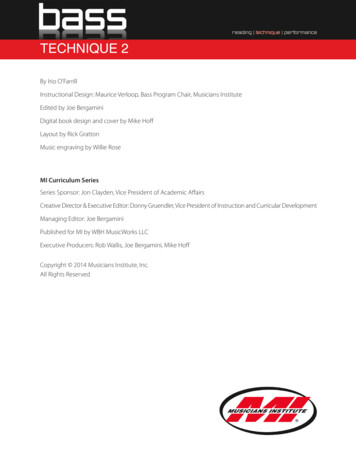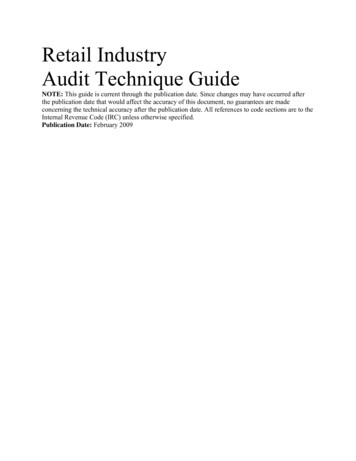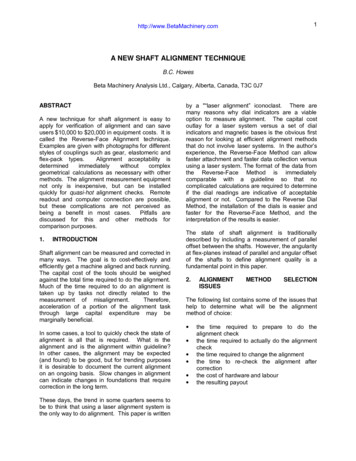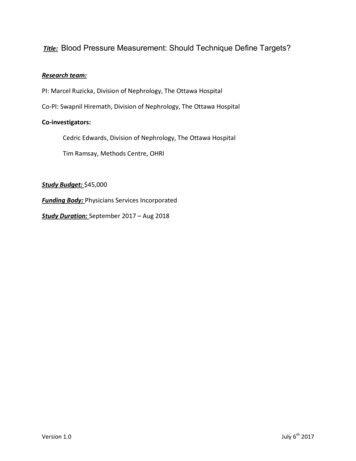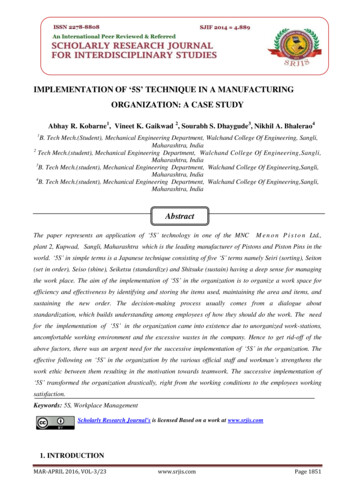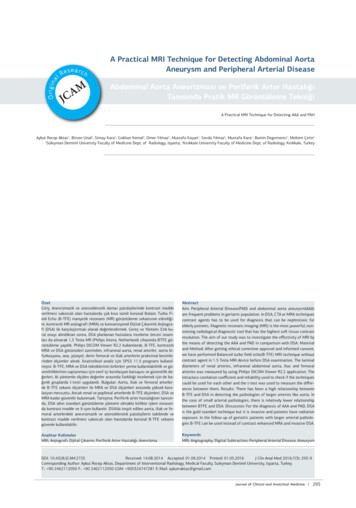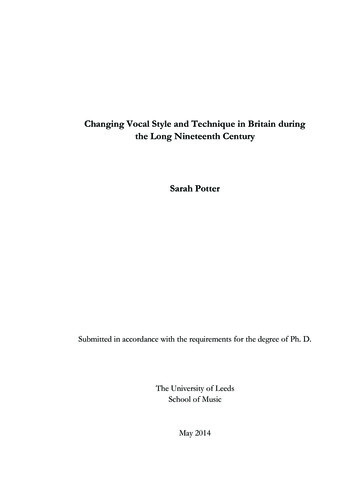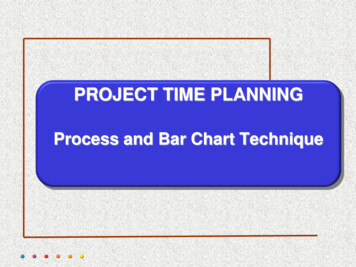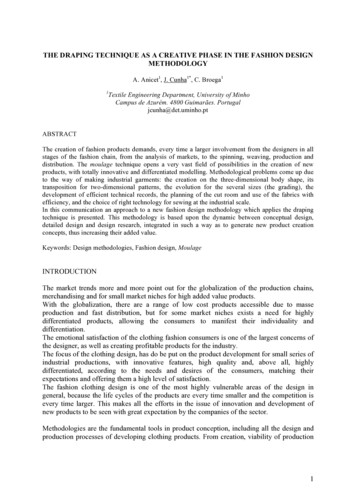
Transcription
THE DRAPING TECHNIQUE AS A CREATIVE PHASE IN THE FASHION DESIGNMETHODOLOGYA. Anicet1, J. Cunha1*, C. Broega11Textile Engineering Department, University of MinhoCampus de Azurém. 4800 Guimarães. Portugaljcunha@det.uminho.ptABSTRACTThe creation of fashion products demands, every time a larger involvement from the designers in allstages of the fashion chain, from the analysis of markets, to the spinning, weaving, production anddistribution. The moulage technique opens a very vast field of possibilities in the creation of newproducts, with totally innovative and differentiated modelling. Methodological problems come up dueto the way of making industrial garments: the creation on the three-dimensional body shape, itstransposition for two-dimensional patterns, the evolution for the several sizes (the grading), thedevelopment of efficient technical records, the planning of the cut room and use of the fabrics withefficiency, and the choice of right technology for sewing at the industrial scale.In this communication an approach to a new fashion design methodology which applies the drapingtechnique is presented. This methodology is based upon the dynamic between conceptual design,detailed design and design research, integrated in such a way as to generate new product creationconcepts, thus increasing their added value.Keywords: Design methodologies, Fashion design, MoulageINTRODUCTIONThe market trends more and more point out for the globalization of the production chains,merchandising and for small market niches for high added value products.With the globalization, there are a range of low cost products accessible due to masseproduction and fast distribution, but for some market niches exists a need for highlydifferentiated products, allowing the consumers to manifest their individuality anddifferentiation.The emotional satisfaction of the clothing fashion consumers is one of the largest concerns ofthe designer, as well as creating profitable products for the industry.The focus of the clothing design, has do be put on the product development for small series ofindustrial productions, with innovative features, high quality and, above all, highlydifferentiated, according to the needs and desires of the consumers, matching theirexpectations and offering them a high level of satisfaction.The fashion clothing design is one of the most highly vulnerable areas of the design ingeneral, because the life cycles of the products are every time smaller and the competition isevery time larger. This makes all the efforts in the issue of innovation and development ofnew products to be seen with great expectation by the companies of the sector.Methodologies are the fundamental tools in product conception, including all the design andproduction processes of developing clothing products. From creation, viability of production1
until the introduction of the final product in the market, the methodology is present in such away that the acceptance by the costumers is analysed and is critical for the product life cycle.The creation of fashion products is very demanding for the designers, both textile and appareldesigners. People working in the creative field are constantly required to come up with ideasto design schemes, rules and construction methods that are, at the times, complicated andrestrictive. Creativity is often force into second place. Thus, we propose the idea ofsuggesting a simplified design methodology to use when time is short.This communication presents a new approach to the fashion design methodologies forclothing, by applying the draping technique (moulage) as basis of the creation stage. Theresulting approach or methodology is based upon the dynamics between conceptual design,detailed design and design research, integrated in such a way as to generate new productcreation concepts, thus increasing their added value.The draping technique, also referred as moulage, opens a vast field of possibilities in thecreation of new products with total innovation and differentiated patterns. The advantages canbe even more significant if this technique is applied to the development of customised anddifferentiated female clothing products.The moulage initially was used for creating exclusive products, with no industrial purpose,but what is proposed here is the creation of a method for industrial scale. The moulage(draping) is a technique that works de material directly on the body by wrapping it, taking thebest benefit of the draping characteristic of the materials.Cloths wrapped around the body have been the basis of the dress of peoples all over the worldfor centuries. In many countries and cultures, it still is the main way of dressing, or at least animportant aspect of ceremonial attire. For instance, richly decorated Saris are worn by womenthroughout the India sub-continent, it is probably the most elaborate garment consisting ofjust one piece of unstitched cloth. It is the art of wrapping a piece of cloth around the body [1].For this research study, a multi-functional female garment was created through the drapingtechnique, having in mind its development for industrial production. Therefore the researchwork is based on the analysis of the creation process of garments, flexible and capable to bemodified by the user has she pleases to, or needs to, depending on the occasion.The draping technique has some advantages in its use. The first is related to creativity, for itcan be considered as a sculpting technique, where the artist moulds the fabric on the body,defining the 3D form through the dialogue between its imagination and the behaviour of thefabric in the body. The draping technique presents itself as a tool that favours the innovationin the fashion area, as it can be seen in the works of Madeleine Vionnet and Madame Grés[2], who were masters in the generation of new garment forms, pattern making and creation ofnew volumes and shapes in garment construction. The second advantage is related to thetechnical garment construction. Once the pattern can be extracted from the direct contact ofthe fabric with the body, there can be a greater accuracy in the pattern making, thus enablingthe product with a higher final quality.DESIGN METHODOLOGIES APPLIED TO FASHION GARMENTSThe traditional fashion garment design processes [3] are based on the scheme presented infigure 1(a), were the design research is centred in the analysis of the fashion and market2
trends, consumer studies (life style, ambitions, worries, tastes, desires), brand concept (whenthere is one), in the observation, inspiration, innovation and finally on the research ofinnovative garment production methods and processes.Then comes the product development phase, were several decisions are made in the definitionof the silhouette, shape, lines, proportions, colours, textures, cut and study of productionmethods. In the prototyping phase the garment is developed having in mind the proportions,the three-dimensionality, the materials and the fabric draping. After adjustments an evaluationand technical production sheets are made.In the method that we are developing there are major differences from the tradition method,one of which and perhaps the most important is that the research in design is not a staticprocess, but continuous and interactive with the experimental product developmentprocess/phase (figure 1(b)).The research in design in our approach is not depleted in the knowledge of the market, theconsumer and the fashion trends; it also encloses a profound knowledge of the materials andtheir relation with the silhouette. It is a process that besides being a reflected process is alsoexperimental and interactive, thus being a dynamic process.DesignBriefDesign BriefResearch inDesignConceptualDesignPrototypingD e s ig nProductResearchd e v e lo p m e n tP r o t o t y p in gm a r k in gp la n s a n dg r a d in gFinal product(a)FinalProduct(b)Figure 1 – (a) Traditional method of clothing design and creation; (b) Interactive method ofdesign and creation of fashion garmentsAs can be seen in the interactive method that we are developing (figure 1(b)), the designresearch phase exists in interaction with product developing and prototypingphases/processes. In this interaction, projected to be dynamic, issues related with formalresearch are worked experimental and dynamically with the silhouette, shapes, lines,proportions, colours, textures, cutting and the study of production methods and with theexperimental developmental of the clothing item.This process or phase ends only when the final product is achieved, completely finished, andat the same time, the knowledge for its industrial production is achieved.The most significant difference between this and the traditional method is the achievement ofa much solid knowledge on the materials, of the product itself and of its construction.Therefore the purpose is to build a sustainable base that allows an evolution in the sense tomake more viable the development of this sort of products.This approach to the development of fashion products combining some of the phases in thetraditional process with the draping techniques, allows the assurance of the appearance of thefinal product both in aesthetic as in functional terms, for it is based on the knowledge of the3
materials properties achieved through experimentation. In this way, it is possible to take agreater advantage of the materials to be used and to build a knowledge database increasinglylarger in this domain.The experimentation allows at the same time to reflect on the interaction of the binomialmaterial-silhouette in the shape of the finish product, exploring in a more dynamic way theemotional creativity of designer, allowing an integrated innovation in the created products.EXPERIMENTAL WORKWith the intention to develop this methodology for fashion products creation and to validatethis concept of dynamic research in design, a deep research work is being carried, which is anintegrant part of a master thesis in course.The methodology that we intend to develop with this study also means to give a specialattention to the process of bi-dimensioning the products created through the draping techniqueand its consequent gradation.In adopting this method, several are the problems that still need to be studied and analyzed,such as the adequacy of the artistic process of clothes construction with draping techniques tothe industrial production; how to make the scaling of these patterns; how to make a technicalsheet in a way that it’s intelligible in a clear and objective way; the form of presenting theseproducts to the final consumer, since their way of dressing is difficult to be visualized, andconsequently, it’s sale is harmed in this aspect; and last, but not least, the best way tohighlight the product at the point of sale.During this process and from a technical point of view, the aim is to simplify the shape,meaning the pattern design, in order to achieve line production goals and clothing withcontrolled costs. For this purpose, some methods for simplifying the pattern designs must bedeveloped so that we can have a methodology suitable for the development of pattern designseasy to use in an industrial plant, where workers are used to work with conventional clothes,which mean traditional patterns.In this process of simplifying the pattern design, practical issues will be addressed, such as: How to do the markings on the clothing item and on the patterns? How to simplify some seems that present themselves with a curve shape in themoulage clothing item? How to expose, to the technical staff, in a simple and clear way, the complexity of theitems? How to simplify the clothing item, “cleaning it” without loosing its innovativeexpression, differentiation and design?The product design research phase becomes essential throughout this project, since this is amulti and interdisciplinary project it requires to the designer involved in it, a profoundknowledge of the materials, therefore demanding a complete understanding of the productiveprocesses as well as product management.4
Figure 2 – Prototypes used in the development of this methodology.CONCLUSIONSOne of the great innovations that can generate successful products in the global fashionmarket is the development of new approach methodologies to the design process that enablethe generation of new products, more creative and innovative. These can lead to products withhigh levels of market acceptance and that at the same time present a higher added value.The return of the draping technique, or moulage, as an innovation tool will be a reality if, onthe design process, the challenge of developing an accurate and precise way of preparing theflat patternmaking from the draped model is overcome. Then it will be possible to applytraditional industrial sewing techniques or even, in order to keep up with the acceleratedtechnological advances, think of new techniques, such as seamless that point towards atechnological revolution in clothing mass production.Fashion designers need to be ever more creative to develop clothes with more innovation,with reduced production time, resulting in differentiated clothing items with low productioncost and high profit edge for the companies. Many times the geniality lays in simplicity. If thefashion designer is able to develop completely innovative pieces, with few seems,comfortable, with high quality and aesthetically appealing, that will result in the consumersatisfaction as well as in the satisfaction of the people involved in its production. For, if wecan produce a clothing item that has all the characteristics above mentioned, the productiontime will be reduced and consequently there will be an increase in the daily production andthe companies profit will grow.5
REFERENCES[1] E. K. Drudi, Wrap & Drape Fashion, The Pepin Press, 2007.[2] L. Kamitsis. Vionnet: Fashion Memoir, Thames and Hudson, 1996.[3] K. McKelvey, J. Munslow,
In this communication an approach to a new fashion design methodology which applies the draping technique is presented. This methodology is based upon the dynamic between conceptual design, detailed design and design research, integrated in such a way as to generate new product creation concepts, thus increasing their added value. Keywords: Design methodologies, Fashion design,
